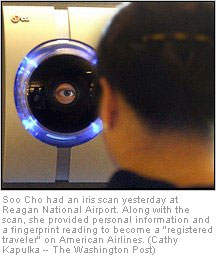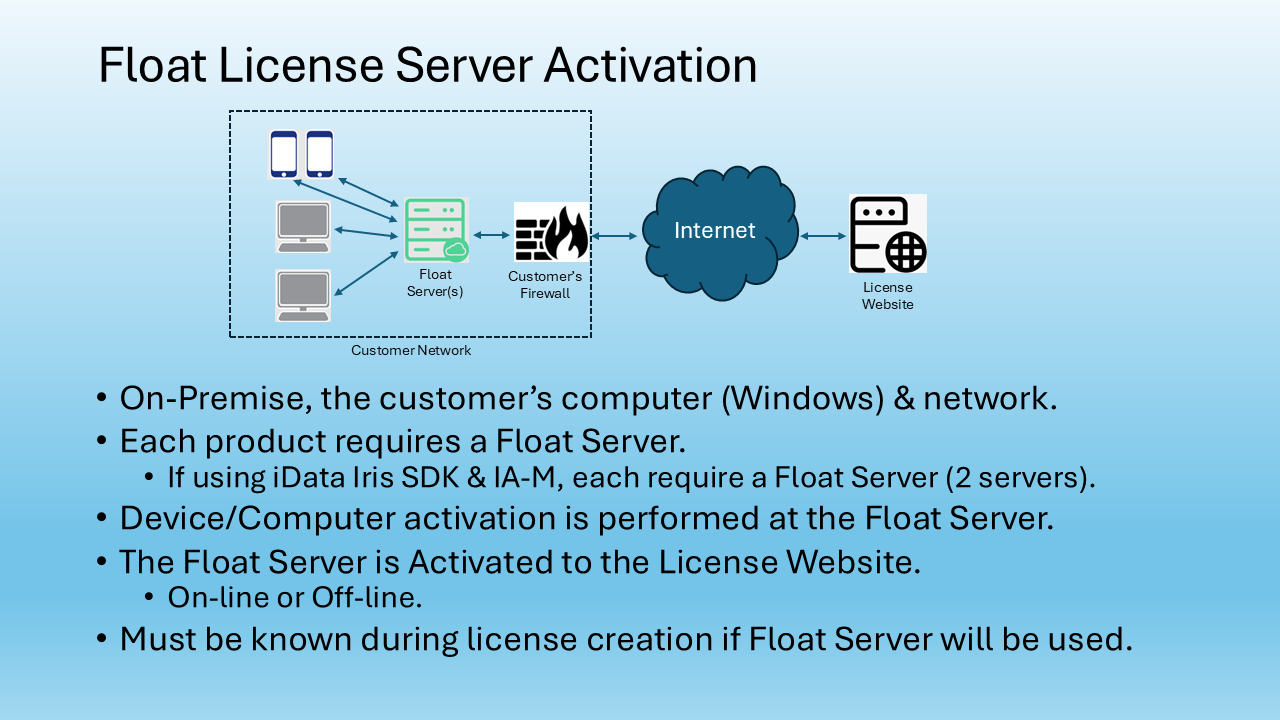by Sara Kehaulani Goo, Staff Write, Washington Post
http://www.washingtonpost.com/wp-dyn/articles/A30178-2004Aug24.html
Steve Daniels leaned forward for a machine to take a photo of his eye, then placed his right index finger on a small digital scanner. Instantly, a large black and white image of his fingerprint appeared on a screen. The image wiggled slightly as Daniels moved his finger. “Wow!” he said.
Within seconds, Daniels, a computer consultant whose company is based in Annapolis, joined 125 other local travelers who signed up yesterday to become “registered travelers” at Reagan National Airport. The test project, which aims to give frequent fliers a quicker pass through security checkpoints, is already underway at four other airports. It relies on the latest biometric technologies to verify a passenger’s identity with increased precision. Digital fingerprint scans and photographs are already used to identify foreigners traveling on a visa, and U.S. officials plan to encode a facial recognition technology into passports.
“It was fun — it was also a little weird,” said Mark Senak, an Arlington resident who signed up for the program yesterday and said he had never had his iris scanned. “I travel so much that anything that can lessen the hassle is worth it.”
The Transportation Security Administration and select airlines are cooperating on the program, which will last 90 days at airports in Washington, Boston, Los Angeles, Houston and Minneapolis. The aim at National is to sign up members of Congress and frequent fliers and speed them through a special security lane equipped with scanners. More than 7,000 passengers across the country have signed up so far, and the TSA said hundreds of passengers use the designated security lanes each day.
But the success of the pilot project since its launch in July has been uneven. The Northwest Airlines Corp. program in Minneapolis proved so popular that it exceeded its target enrollment, an airline spokesman said. Northwest had offered 1,000 frequent-flier miles to invited passengers who signed up.
UAL Corp.’s United Airlines, however, did not offer free miles and had less success in Los Angeles when it launched its program last month. When passengers only trickled in to the sign-up counters, the TSA extended the enrollment period an extra week. “It wasn’t really enticing for people to battle L.A. traffic to sign up” at the airport, said United spokesman Jeff Green. He said enrollment has improved, but “it’s so new, I don’t think we can gauge the response at this point.”
A steady stream of passengers handpicked by AMR Corp.’s American Airlines showed up yesterday at a sectioned-off area of National Airport’s baggage claim to submit to the scans, present two forms of government identification and fill out a form that will be used to perform a criminal background check. The form requested a place of birth, birth date, address, e-mail address, home phone number, cell phone number, eye color, U.S. citizenship status, height and residences over the past five years. Eligible passengers will be able to use the new security checkpoint lane after Labor Day.
No members of Congress had signed up yet but 312 passengers had registered so far over the two days of the program at National, a TSA contractor said.
The program offers the first wide application of iris-scanning technology, which had previously been used only for government employees with access to classified sites or for employees with access to nuclear facilities, said Paul Mirenda, director of field operations for LG Electronics Inc., one of the TSA’s contractors that makes the scanners. The technology takes a close-up photograph of the iris, which has more unique characteristics than a fingerprint, and applies digital codes to the photograph to store it as a bar code. The photograph and fingerprint are then stored in a file along with other information about the passenger.
“As far as biometrics go, the iris scan is the most sophisticated measure,” TSA spokesman Darrin Kayser said. “These technologies provide us a high level of assurance that you are who you say you are.”
But some security experts worry that terrorists could apply to become a registered traveler and score an easier pass through security checkpoints. “Registered traveler is simply putting hijackers on airplanes faster,” said Billie Vincent, a former Federal Aviation Administration official. “If you look at 9/11 hijackers, some of them would have qualified as frequent fliers. All they had to do is run a few tests and find out what the parameters were and get people registered.”
The TSA said the program is just one of many security layers. Registered travelers will still have to pass through a metal detector and have their luggage inspected. The benefit, TSA said, is a shorter, dedicated line that will amount to a more predictable wait time for security check-in. Registered travelers will also be exempt from random pat-down screening after they step through the checkpoint.
Selected passengers who fly at least once a week from National Airport received an e-mail from American notifying them of their eligibility for the program. After Labor Day, registered travelers will present a boarding pass to an agent at the special security lane, then place an index finger on the kiosk’s scanner and look into a high-tech camera to provide an iris scan. Within seconds, the machine matches the information with its database and displays a photo and name on a screen, if the passenger is approved to proceed through checkpoint. If the traveler is not approved, a red screen pops up advising: “Wait for assistance.”
Travelers who signed up for the program yesterday said they were impressed with the technology and were eager to be afforded special privileges at the checkpoint. None of the enrollees said they had a problem with providing the government with their personal information.
Indeed, several travelers ticked off a number of cities they had visited in the past week and said they were tired of the unpredictable security lines.
At some airports, like National, there is hardly a line at all. But the lines at others, such as Dulles International and those in Seattle and Dallas, eat up valuable business time.
“I was hoping this might be expanded to BWI and Dulles — they have worse lines,” said Jim Rowan, an investment banker from Chevy Chase.


